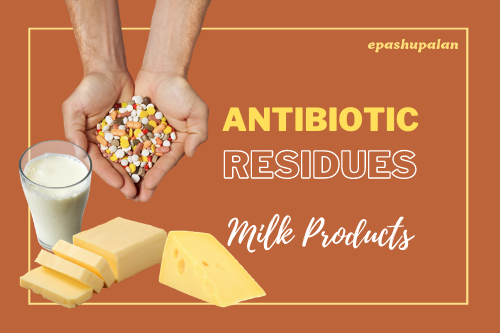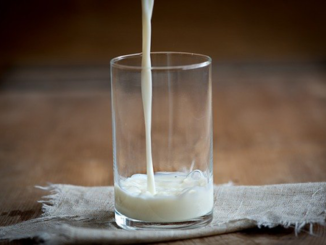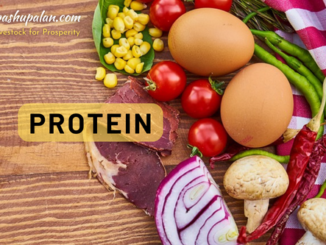Milk and milk products being rich sources of nutrients serve as good mediums for the growth of various micro-organisms thereby responsible for either their spoilage or causing infections/intoxications in consumers. Moreover, in field conditions milking animals are daily suffering from a large number of bacterial infections. To treat these infections, our field veterinarians are regularly using heavy doses of various antibiotics. Antibiotics are the substances obtained from microbes which kill or slow down their growth. Food producing animals are given antibiotics which can be classified into several ways but predominant groups include tetracyclines, floroquinlones, aminoglycosides, pencillins, sulphonamides, macrolides, lincosamides, cephalosporins etc. Some of these are bacteriostatic while others are bactericidal.

What are antibiotic residues?
A residue is literally defined as “that which is left over”. After parenteral administration of antibiotics, certain active or degradation products or their metabolites become deposited in the animal tissues and matrix intended to be used for human consumption, where the concentration is beyond the permitted level for a certain period of time, known as antibiotics residues. The risks of antibiotics residues from the milk and milk products are much higher in developing countries compared to developed ones. This might be due to lack of detection facilities and poor enforcement of standards in the form of Maximum Residue Limits (MRL) set up by the regulatory authorities in the developing countries.
What are the sources of antibiotic residues in milk and milk products?
- Treatment of sick animals and thereby secretion of antibiotics in milk.
- Direct addition of antibiotics to milk as preservatives to prevent its spoilage.
- Use of antibiotics in feed for growth promoters.
- Environmental source or accidental licking of unused drugs by the animals.
What happens when milk with antibiotic residues is boiled or pasteurized?
In addition to treatment of animals, sometimes antibiotics are deliberately added to milk for increasing its shelf life. During heat processing, antibiotics are heat stable and are affected by concentration, chemical nature, composition of dairy products and processing parameters. An antibiotic residual level of 1-2 ppm in fresh milk has been reported to exert its preservative action. Antibiotic residues in milk are relatively stable to pasteurization temperatures and above, as well as to low temperatures (0-10°F). But a loss of about 2.5% of oxytetracycline activity due to pasteurization of fresh milk was documented. Penicillins are more stable in buffalo milk than cow milk.
What is the importance of withdrawal period?
Mastitis is the most prevalent disease in cattle which requires antimicrobial treatment. After treatment every antibiotic has got certain withdrawal period. It is the period during which milk should be withheld for consumption for time up to which antibiotics are secreted in milk. According to the American Dairy Science Association (ADSA), no milk obtained from mastitis treated cow within 72 hours (six milkings) after the last antibiotic treatment is to be processed for human use. The withdrawal period is different for different antibiotics (Table 1) as it depends upon physical and chemical properties of drugs and route of administration.
Table 1: Withdrawl periods of commonly used antibiotics in veterinary practice
| Antibiotic | Route of administration | Withdrawal period (hours) |
| Amoxicillin | Intramammary | 60 |
| Ampicillin | -do- | 48 |
| Cloxacillin | -do- | 48 |
| Penicillin | -do- | 72 |
| Sulphonamides | -do- | 12 |
| Chloramphenicol | -do- | 12 |
| Gentamycin | -do- | 90 |
| Cephapirin | -do- | 96 |
| Pirlimycin | -do- | 36 |
What is Maximum Residue Limit (MRL)?
The Maximum Residue Limit (MRL) is the maximum concentration of residues in milk considered by the authorities as without hazard for the consumer and without effect on the manufacturing processes. MRL is defined as the maximum concentration of a residue, resulting from the registered use of an agricultural or veterinary chemical that is recommended to be legally permitted or recognized as acceptable in or on a food, agricultural commodity, or animal feed. This limit must not exceed for foods of animal origin. The means of applying this MRL at all levels of the industry are not defined by the regulation. Thus, for the dairy industry, the MRL concerns the milk delivered by the producer to the dairy factory and then, non-processed milk. It is impossible to directly apply this MRL to processed products (butter, cheese). As per European Commission, the MRL for sulphonamides is 100 ppb, whereas the MRL values for other antibiotics are given in Table 2.
Table 2: Recommended MRL (µg/kg) and tolerances (USA) values for different antibiotics
| Antibiotic | MRL EU | MRL Codex | USA | PFA |
| Penicillin G | 4 | 4 | 5 | 4 |
| Ampicillin | 4 | – | 10 | |
| Cloxacillin | 30 | – | 10 | |
| Oxacillin | 30 | – | 50 | |
| Ceftiofur | 100 | 100 | 50 | |
| Cephapirin | 10 | – | 20 | |
| Cephalexin | 100 | – | – | |
| Cefalonium | 20 | – | – | |
| Neomycin | 500 | 500 | 150 | |
| Gentamycin | 100 | 200 | 30 | 200 |
| Dihydrostreptomycin | 200 | 200 | 125 | 200 |
| Tetracycline | 100 | 100 | 300 | |
| Oxytetracycline | 100 | 100 | 300 | 100 |
| Chlortetracycline | 100 | 100 | 300 | |
| Erythromycin | 40 | – | 50 | |
| Spiramycin | 200 | 100 | – | |
| Tylosin | 50 | – | 50 |
How we can test antibiotic residues in milk and milk products?
With indiscriminate use of antibiotics in animal husbandry, detection of residual levels of these products in foodstuffs is becoming more and more important. Food authorities have defined acceptable limits (maximum residual levels (MRL) in Europe, safe levels (SL) in the USA) for a range of antibiotics, underlining the need for rapid and sensitive techniques for detecting residues in food products. Previously testing of milk samples for antibiotic residues was performed using various microbiological tests (Delvotest, Br Test, Delvotest SP-NT, Copan Test) and rapid tests (Penzym, Delvo-X-PressM BL, Betastar, Snap, Charm II). Though these tests are cheap, rapid and easy to perform, yet specific tests (microbial inhibition test, biosensor, ELISA, HPLC, LC-MS, LC-MS/MS, UPLC-MS) are considered more selective, accurate and reliable. The chromatographic techniques are more precise with higher specificity and accuracy, but require proper sample preparation, sophisticated instrumentations and well trained personnel. For β-lactam antibiotic residues many of the tests use Bacilus stearothermophilus as the organism to detect. One example on the market is Charm Bacillus stearothermophilus Disc Assay (BSDA) which is designed to detect penicillin G, ampicillin, and cephapirin. Since possibilities of residues in milk from multiclass type of antibiotics is increasing day by day, yet their accurate analysis using a well-developed single technique with minimum cost will always be a challenge.
How antibiotic residues in milk act as a global challenge for human health?
- Human threats: Since milk and milk products are widely consumed by all types of individuals including infants, adults and old age people, hence antibiotic residues constitute a serious threat for humans of all ages. Severe allergic reactions (IgE-mediated) in hypersensitive patients in the form of urticaria, anaphylaxis and angioedema may occur after consumption of milk or its products with antiobiotic residues of penicillin, novobiocin etc. Non allergic reactions (Non IgE-mediated) may occur in the form of hemolytic anemia, thrombocytopenia, acute interstitial nephritis, serum sickness, vasculitis, erythema, toxic epidermal necrolysis etc. Milk with tetracycline residues in it, binds with calcium of body and causes discolouration of teeth in addition to adverse effects on the growth of children. Antibiotic residues may cause interference in the intestinal flora and resistant populations of bacteria in the general populations, thereby rendering antibiotic treatment ineffective. Also prolonged intake of tetracycline in milk decreases immunity by decreasing antibodies in milk. On the other hand, excess of chloramphenicol residues in milk may cause aplastic anaemia, optic neuritis, brain abscess and Grey baby syndrome. Presence of sulpha drugs and nitrofurans in milk may cause toxicological effects in human in addition to their carcinogenic and mutagenic effects.
- Environmental threats: The contamination of environment with different antibiotics may occur via faeces of animals, unused drugs, manufacturing process of antibiotics etc. Animals excrete significant amounts of tetracyclines and other groups of antibiotics in urine and faeces which constitute environmental contamination. Persistence of these antibiotic residues in the environment for long periods may contaminate aquatic and terrestrial ecosystems, thereby further causing threat to aquatic and terrestrial life. Antibiotic residues also change soil friendly bacteria and cause changes in fungal to bacteria ratio, affecting its fertility.
- Antimicrobial resistance: Due to prolonged use of sublethal doses of antibiotics, there is development of drug resistance. The use of manure with antibiotic residues for soil fertilization may cause development of resistant bacteria and resistance genes. This may cause development of resistance in humans via food animals causing poor response to treatment during illness. According to an estimate, every year, about 500000 human deaths occur due to antimicrobial resistance.
How antibiotic residues in milk act as a global challenge for dairy industry?
- In Dairy industry, all starter cultures are highly susceptible to very low concentrations of antibiotic residues. These residues cause culture failure, reduction of milk curdling and subsequent loss of dairy products. It has been documented that a concentration of 1 ppb of Penicillin, delay starter activity for several hours during preparation of dairy products.
- Antibiotic residues may decrease the acid and flavour production associated with butter manufacture.
- The presence of antibiotic residues in milk makes its processing into cultured milk products difficult due to inhibition in the growth of starter culture, which in turn constitutes an enormous economic loss to the dairy industry.
- During the preparation of cheese, antibiotic residues in milk slow down the growth of starter culture, and thus the resultant slow decrease in acidification may enable the growth of undesirable pathogenic bacteria, which affects the safety of product.
- Antibiotic residues interfere with starter metabolism, inhibit production of lactic acid, and thus produce off flavours and poor quality products leading to higher economic losses.
- A change in consumer perception of milk being a pure, unadulterated and natural product.
- The biggest challenge to dairy industry in global market is the non-compliance of international standards for food safety requirements. This hinders the import and export of value added dairy products from India due to antibiotic residues.
What is the need of the hour?
- In India, many dairies do not perform regular testing of antibiotic residues in milk. Moreover there is lack of awareness on detection tests. Hence dairy industry must take proactive steps for regular screening of milk samples for antibiotic residues.
- Antibiotic contaminated milk should not be consumed during withdrawal period. Also it should not be mixed with good quality milk. FAO and WHO have recommended MRL values for milk, and thus milk exceeding this limit should be avoided.
- For prevention of antibiotic residues in raw milk, there should be implementation of HACCP (Hazard Analysis Critical Control Point) procedure which is a part of milk quality assurance program for antibiotic avoidance.
- To eliminate the chances of antimicrobial resistance, antimicrobials should be used for the control or treatment of infectious diseases only. While doing so, proper dose and schedule of antibiotic administration must be followed as per the guidelines given by FAO, OIE etc. About 27 different antimicrobial classes are used in animals. However, only 42 countries have a system to collect data on the use of antimicrobials in livestock. Hence regular and stringent monitoring system should be followed in all countries for antibiotic administration.
- Antibiotics which are used as feed additives should be prescribed and sufficient.
- Creation of awareness among public and producers regulating occurrence, elimination and their effects.
References
- Jayalakshmi, K., Paramasivam, M., Sasikala, M., Tamilam, T.V. and Sumithra, A. 2017. Review on antibiotic residues in animal products and its impact on environments and human health. Journal of Entomology and Zoology Studies. 5(3): 1446-1451.
- Kaya, S.E. and Filazi, A. 2010. Determination of antibiotic residues in milk samples. Kafkas Univ Vet Fak Derg. 16(Suppl-A): S31-S35.
- Priyanka, P.S., Sheoran, M.S. and Ganguly, S. 2017. Antibiotic residues in milk – a serious public health hazard. Journal of Environment and Life Sciences. 2(4): 99-102.
- Rathe, H.A.A. and Al-Shaha, O.M. 2017. Detection of antibiotic residues in milk and milk products of cattle in dairy Farms in Baghdad region. Journal of Entomology and Zoology Studies. 5(3): 1797-1802.
- Sachi, S., Ferdous, J., Sikder, M.H. and Hussani, S.A.K. 2019. Antibiotic residues in milk: Past, present, and future. Journal of Advanced Veterinary and Animal Research. 6(3): 315-332.
- Singh, P. and Gandhi, N. 2015. Milk preservatives and adulterants: processing, regulatory and safety issues. Food Reviews International. 31(3): 236-261.
- Singh, P., Singh, T.P. and Gandhi, N. 2018. Prevention of lipid oxidation in muscle foods by milk proteins and peptides: a review. Food Reviews International. 34(3): 226-247.






Be the first to comment